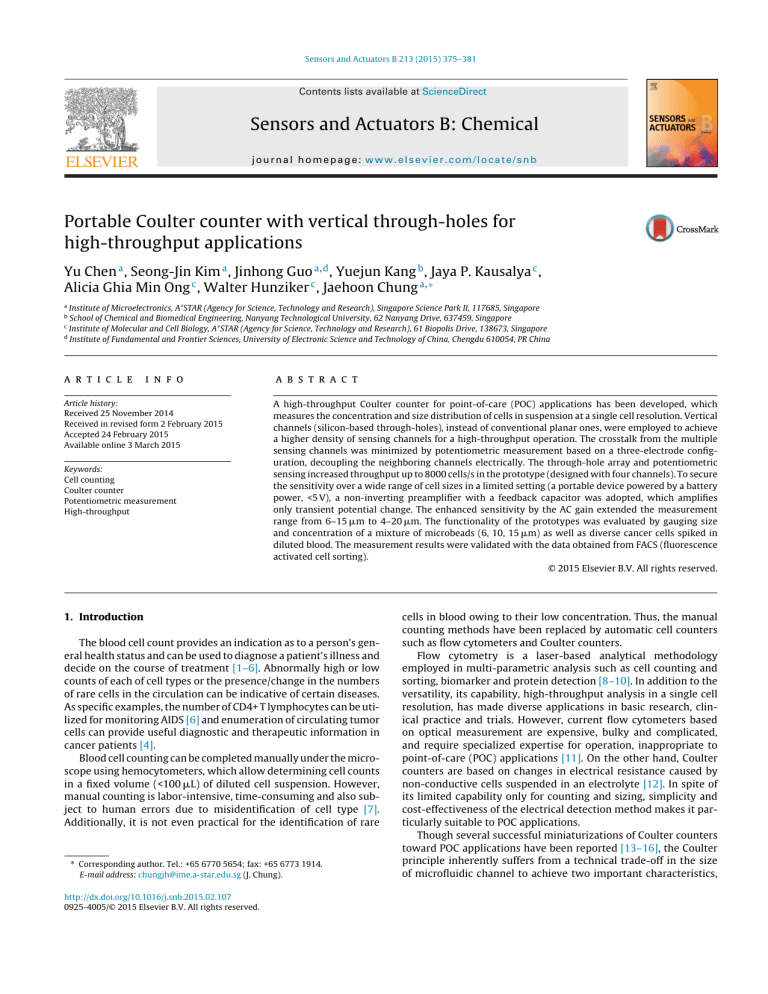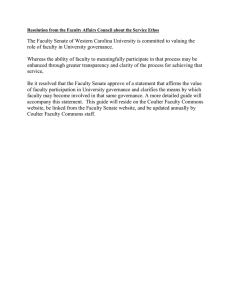
Sensors and Actuators B 213 (2015) 375–381
Contents lists available at ScienceDirect
Sensors and Actuators B: Chemical
journal homepage: www.elsevier.com/locate/snb
Portable Coulter counter with vertical through-holes for
high-throughput applications
Yu Chen a , Seong-Jin Kim a , Jinhong Guo a,d , Yuejun Kang b , Jaya P. Kausalya c ,
Alicia Ghia Min Ong c , Walter Hunziker c , Jaehoon Chung a,∗
a
Institute of Microelectronics, A*STAR (Agency for Science, Technology and Research), Singapore Science Park II, 117685, Singapore
School of Chemical and Biomedical Engineering, Nanyang Technological University, 62 Nanyang Drive, 637459, Singapore
c
Institute of Molecular and Cell Biology, A*STAR (Agency for Science, Technology and Research), 61 Biopolis Drive, 138673, Singapore
d
Institute of Fundamental and Frontier Sciences, University of Electronic Science and Technology of China, Chengdu 610054, PR China
b
a r t i c l e
i n f o
Article history:
Received 25 November 2014
Received in revised form 2 February 2015
Accepted 24 February 2015
Available online 3 March 2015
Keywords:
Cell counting
Coulter counter
Potentiometric measurement
High-throughput
a b s t r a c t
A high-throughput Coulter counter for point-of-care (POC) applications has been developed, which
measures the concentration and size distribution of cells in suspension at a single cell resolution. Vertical
channels (silicon-based through-holes), instead of conventional planar ones, were employed to achieve
a higher density of sensing channels for a high-throughput operation. The crosstalk from the multiple
sensing channels was minimized by potentiometric measurement based on a three-electrode configuration, decoupling the neighboring channels electrically. The through-hole array and potentiometric
sensing increased throughput up to 8000 cells/s in the prototype (designed with four channels). To secure
the sensitivity over a wide range of cell sizes in a limited setting (a portable device powered by a battery
power, <5 V), a non-inverting preamplifier with a feedback capacitor was adopted, which amplifies
only transient potential change. The enhanced sensitivity by the AC gain extended the measurement
range from 6–15 m to 4–20 m. The functionality of the prototypes was evaluated by gauging size
and concentration of a mixture of microbeads (6, 10, 15 m) as well as diverse cancer cells spiked in
diluted blood. The measurement results were validated with the data obtained from FACS (fluorescence
activated cell sorting).
© 2015 Elsevier B.V. All rights reserved.
1. Introduction
The blood cell count provides an indication as to a person’s general health status and can be used to diagnose a patient’s illness and
decide on the course of treatment [1–6]. Abnormally high or low
counts of each of cell types or the presence/change in the numbers
of rare cells in the circulation can be indicative of certain diseases.
As specific examples, the number of CD4+ T lymphocytes can be utilized for monitoring AIDS [6] and enumeration of circulating tumor
cells can provide useful diagnostic and therapeutic information in
cancer patients [4].
Blood cell counting can be completed manually under the microscope using hemocytometers, which allow determining cell counts
in a fixed volume (<100 L) of diluted cell suspension. However,
manual counting is labor-intensive, time-consuming and also subject to human errors due to misidentification of cell type [7].
Additionally, it is not even practical for the identification of rare
∗ Corresponding author. Tel.: +65 6770 5654; fax: +65 6773 1914.
E-mail address: chungjh@ime.a-star.edu.sg (J. Chung).
http://dx.doi.org/10.1016/j.snb.2015.02.107
0925-4005/© 2015 Elsevier B.V. All rights reserved.
cells in blood owing to their low concentration. Thus, the manual
counting methods have been replaced by automatic cell counters
such as flow cytometers and Coulter counters.
Flow cytometry is a laser-based analytical methodology
employed in multi-parametric analysis such as cell counting and
sorting, biomarker and protein detection [8–10]. In addition to the
versatility, its capability, high-throughput analysis in a single cell
resolution, has made diverse applications in basic research, clinical practice and trials. However, current flow cytometers based
on optical measurement are expensive, bulky and complicated,
and require specialized expertise for operation, inappropriate to
point-of-care (POC) applications [11]. On the other hand, Coulter
counters are based on changes in electrical resistance caused by
non-conductive cells suspended in an electrolyte [12]. In spite of
its limited capability only for counting and sizing, simplicity and
cost-effectiveness of the electrical detection method makes it particularly suitable to POC applications.
Though several successful miniaturizations of Coulter counters
toward POC applications have been reported [13–16], the Coulter
principle inherently suffers from a technical trade-off in the size
of microfluidic channel to achieve two important characteristics,
376
Y. Chen et al. / Sensors and Actuators B 213 (2015) 375–381
the throughput and sensitivity. A large size channel is preferred for
high-throughput device, while a small size channel can provide better sensitivity. In order to realize high throughput Coulter counter
device with the same level of sensitivity, multi-channel configurations have been explored [17]. But such an approach has caused an
inter-channel crosstalk; therefore, restricting sensitivity, induced
by sharing biasing electrodes from an inlet and an outlet. To address
the crosstalk issue in multiple channels, Jagtiani et al. has utilized
multiple frequencies for each channel [18] and efficiently suppressed the crosstalk. However, it complicated the circuit design
and resulted in limited bandwidth, especially when the number
of channels increased. Kim et al. explored a multichannel cytometer for the high-throughput analysis, but their horizontal channel
design has limited the scalability to extend to a larger density array
[19].
In this work, we described a Coulter counter with multiple
vertical through-holes as microfluidic channels and the potentiometric measurement with a three-electrode configuration. The
proposed vertical through-hole design preliminarily demonstrated
the potential to expand it to a high-density array. In addition, the
potentiometric method minimized crosstalk by decoupling signals from the neighboring channels. Especially, a concept of AC
gain configuration was employed to amplify only transient potential change to increase sensitivity. We fabricated a prototype with
vertical through-holes and electrodes by sandwiching a silicon substrate with two PDMS microchannel layers. Using the devices, the
enhanced sensitivity was demonstrated by measuring diverse sized
microbeads and cells in a suspension.
2. Methods and materials
2.1. Materials and sample preparation
Sylgard 184 Silicone Elastomer Kit, which was used for the fluidics channel fabrication, was purchased from Ellsworth Adhesives
Asia Ltd. Polystyrene beads were purchased from Polysciences, Inc.
(Catalog #15714-5 (6 m), 17136-5 (10 m), 18328-5 (15 m)).
Phosphate-buffered saline (PBS) was obtained from Sigma–Aldrich
(USA). Pluronic F-108 was obtained from Brylchem Pte Ltd,
Singapore. Single donor human whole blood was obtained from
Innovative Research (MI, USA) (Lot ID: 23 69146B; anticoagulant:
K2 EDTA; gender: male; age: 28).
MDA-MB231 (ATCC CRM-HTB-26) is a human breast cancer cell
line derived from an adenocarinoma. The cells were cultured in low
glucose DMEM (Gibco, cat# 11995-065), 10% fetal bovine serum
(Gibco, cat# 16000-044), 2 mM penicillin–streptomycin (Gibco,
cat# 15140-122) and 2 mM l-glutamine (Gibco, cat# 25030-081).
Cells were cultured at 37 ◦ C in a 5% CO2 atmosphere in T75 flasks.
MCF-7 cells (American Type Culture Collection, MD, USA)
derived from breast adenocarcinoma were cultured in minimum
essential media (MEM) (Gibco, cat# 11095-080) supplemented
with 10% fetal bovine serum (FBS) (Gibco, cat# 10270106), 1 mM
sodium pyruvate (Gibco, cat# 11360-070), 0.1 mM MEM nonessential amino acids (Gibco, cat# 11140-050) at 37 ◦ C in a 5% CO2
atmosphere in T75 flasks.
All microfluidic channels were coated with Pluronic co-polymer
F108 prior to usage [20,21]. The antifouling property of the copolymer repels proteins and other adsorbent from the surface by
steric repulsion, minimizing non-specific binding of microbeads or
cells onto the fluidic channel walls.
prepared. The cast mold for the upper microfluidic channel was
fabricated by patterning a 40 m thick single layer of SU8-2025
photoresist (Microchem) on an 8 in. silicon substrate. On the other
hand, the mold for the lower channel was laser-micromachined
by cutting a 2 mm thick PMMA sheet (Marga Cipta) to make much
lower resistance compared with the upper channel. These molds
were replicated by casting and curing liquid PDMS at 65 ◦ C for
4 h. The cured 4 mm thick PDMS layers were sliced into blocks
(10 mm × 8 mm), where holes were generated by a biopsy punch
(1.1 mm in a diameter) for connecting tubing. The middle layer,
silicon substrate was separately fabricated. First, the areas of the
vertical through-holes (circular shape, 30 m of a diameter) were
defined by photolithography and the area was dry-etched in a depth
of 20 m with a DRIE (deep reactive ion etcher) from the top surface. Then sensing and shared bias electrode 1 (Ti/Pt electrodes)
are defined by lift-off process. Then the wafer was thin down to
400 m and etched from the back side to form the bigger micro
hole with 300 m diameter. After preparing the three individual
components, the two PDMS blocks were aligned and bonded permanently to the silicon substrate by treating with the O2 plasma on
both surfaces. One Pt wire was inserted into the outlet channel for
the shared bottom bias electrode 2. The fabrication process of the
silicon substrate was illustrated in Fig. S1 in detail.
2.3. FACS measurement
To obtain accurate concentration and size information of cells
in suspension, flow cytometry analysis (BD LSRII Flow Cytometry
Analyser) was used and compared with our experimental results.
Prior to the comparison experiment, the flow cytometer was calibrated with a size calibration kit (Molecular Probes, F-13838)
by comparing the forward scatter (FSC) signal with a population
of microsphere standards of known diameters. After the calibration, CountBrightTM absolute counting beads (Molecular Probes,
C36950) consisting of a known concentration of microspheres were
added to the sample (cells suspended in PBS with 5% FBS) to
determine the cell concentration more accurately. Particle size distribution was obtained using the calibrated forward-scatter signal.
The cell concentration can be calculated using the formulae based
on the number of bead and cell events according to manufacturers’
instructions.
3. Results
3.1. Device design
Fig. 1a illustrates the schematics of a single unit in the potentiometric Coulter counter. A silicon substrate embedded with three
electrodes and a vertical through-hole is sandwiched by upper (R1 )
and lower (R2 ) polydimethylsiloxane (PDMS) microfluidic channel
layers (Fig. 1b). A cell suspension introduced from the inlet follows
upper, sensing (through-hole), and lower channels sequentially,
then is collected from the outlet, as shown in Fig. 1c. To measure
the electrical resistance change caused by Coulter principle, a bias
voltage is applied over the entire channel by two electrodes near
the inlet and the outlet. The voltage at the through-hole is measured at a sensing electrode. The microfluidic channels filled with
electrolytes form a series of resistor network so that the voltage
divider determines the sensing voltage (Vs ),
Vs = V2 + (V1 − V2 ) ·
2.2. Device fabrication
The prototype was fabricated by sandwiching one silicon substrate between two PDMS layers. The three layers were separately
R0 + R2
R1 + R0 + R2
where V1 and V2 are the voltages applied to the upper and lower
electrodes, and R0 , R1 , and R2 are the electrical resistance of the
sensing, upper, and lower sensing channels, respectively.
ID
750711
Title
Portable Coulter counter with vertical through-holes for high-throughput applications
http://fulltext.study/article/750711
http://FullText.Study
Pages
7


